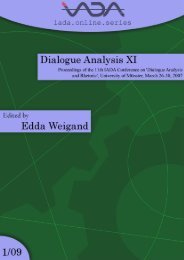Dialogue in and between Different Cultures - International ...
Dialogue in and between Different Cultures - International ...
Dialogue in and between Different Cultures - International ...
You also want an ePaper? Increase the reach of your titles
YUMPU automatically turns print PDFs into web optimized ePapers that Google loves.
Contrastive Analysis of English <strong>and</strong> Polish Military Texts 89<br />
− Sample 2 - correspond<strong>in</strong>g passages of STANAG 2830, titled Material<br />
H<strong>and</strong>l<strong>in</strong>g Aids;<br />
− Sample 3 - chapter 4 “Medical <strong>and</strong> veter<strong>in</strong>ary support” of the logistics manual<br />
Tactical rear (1973);<br />
− Sample 4 - chapter 8 “Medical support” of L<strong>and</strong> Forces Logistic Doctr<strong>in</strong>e<br />
(ALP-9);<br />
− Sample 5 - chapter 3 of L<strong>and</strong> Forces Logistic Doctr<strong>in</strong>e discuss<strong>in</strong>g logistics<br />
plann<strong>in</strong>g;<br />
− Sample 6 - chapter 2 “General characteristics of logistic support plann<strong>in</strong>g” of<br />
the Polish manual Brigade <strong>and</strong> division logistic support comm<strong>and</strong> <strong>in</strong> defense<br />
<strong>and</strong> attack (1996).<br />
To conduct a contrastive analysis of Polish <strong>and</strong> NATO logistics texts, I decided to<br />
apply some elements of de Beaugr<strong>and</strong>e <strong>and</strong> Dressler’s (1997, after Duszak<br />
1998:122) <strong>in</strong>teractive model of text <strong>and</strong> discourse process<strong>in</strong>g. Such a discourse<br />
research model underlies the practice which generates communicative phenomena<br />
rather than its end-products only. What is important, it <strong>in</strong>troduces possible<br />
strategies rather than strict rules. That approach also gives primary significance to<br />
the <strong>in</strong>teractive character of human patterns of behaviour <strong>in</strong> society. Last but not<br />
least, this textual research methodology stresses the importance of context for the<br />
production of social languages which are characteristic of some social groups, or<br />
conventionalized, recurrent situations. Its process<strong>in</strong>g doma<strong>in</strong>s are enumerated<br />
below with a short description.<br />
Goal-plann<strong>in</strong>g – that stage is most pragmatic of all; this is a stage of problem<br />
solv<strong>in</strong>g, express<strong>in</strong>g <strong>in</strong>tentions, seek<strong>in</strong>g solutions, analyz<strong>in</strong>g extra l<strong>in</strong>guistic<br />
context, roles of discourse participants, <strong>and</strong> select<strong>in</strong>g text strategies.<br />
Topicaliz<strong>in</strong>g – de Beaugr<strong>and</strong>e <strong>and</strong> Dressler’s (1997) topicalization <strong>and</strong><br />
concept-elaboration levels of discourse analysis draw researchers’ attention to the<br />
ways <strong>in</strong> which <strong>in</strong>formation is organized. They po<strong>in</strong>t to the techniques which<br />
writers use to organize their message. In my op<strong>in</strong>ion, topicaliz<strong>in</strong>g corresponds to<br />
what Trimble (1985) labels Level C of rhetorical analysis where a researcher<br />
looks for the specific rhetorical functions <strong>in</strong> the total discourse. Those functions<br />
are usually revealed <strong>in</strong> the <strong>in</strong>troductory section of a given piece of writ<strong>in</strong>g. In<br />
other words, a rhetorical function is def<strong>in</strong>ed as a name for what the discourse unit<br />
under exam<strong>in</strong>ation tries to achieve. Dur<strong>in</strong>g such an oriented analysis, researchers<br />
should look for descriptions, def<strong>in</strong>itions, classifications, <strong>and</strong> <strong>in</strong>structions; <strong>in</strong><br />
addition, they should exam<strong>in</strong>e visual-verbal relationships.<br />
Concept-elaborat<strong>in</strong>g – the idea of concept-elaboration refers to Trimble’s<br />
Level D where specific rhetorical techniques are discussed. Rhetorical techniques<br />
are elements that b<strong>in</strong>d together the <strong>in</strong>formation <strong>in</strong> a given piece of text. Generally,<br />
at this level two subsections can be discrim<strong>in</strong>ated. These are orders or natural<br />
patterns which are frameworks determ<strong>in</strong>ed by the nature of the material which<br />
they present, e.g. time order, space order, cause <strong>and</strong> result order. On the other<br />
h<strong>and</strong>, there are logical patterns which are patterns deliberately chosen by writers



